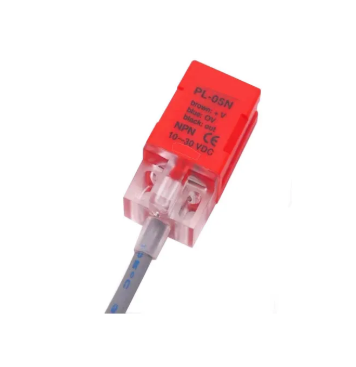Key Features of Proximity Switches for Harsh Environments
Durability Against Extreme Temperatures
Proximity switches designed for harsh environments must withstand extreme temperatures ranging from -40°C to as high as 100°C or more. These devices are often used in industries such as oil and gas, where temperature fluctuations are routine. To endure these conditions, proximity switches are crafted using robust materials like stainless steel and high-grade plastics, which prevent warping or failure from intense heat or freezing temperatures. According to industry observations, using durable proximity switches not only minimizes failure rates but also significantly lowers maintenance costs, enhancing their appeal in heavy-duty applications.
Ingress Protection (IP) Ratings Explained
Understanding Ingress Protection (IP) ratings, such as IP67 or IP68, is essential for selecting proximity switches for harsh environments. These ratings denote the level of protection against dust and water exposure, crucial for ensuring the longevity and reliability of devices used in challenging conditions. For example, an IP67 rating ensures that the device is completely dust-tight and can withstand immersion in water for a specified period. The International Electrotechnical Commission (IEC) establishes these standards, guiding manufacturers in determining accurate IP ratings and ensuring that the devices meet necessary protective requirements.
Vibration and Shock Resistance
Proximity switches must endure vibrations and shocks, generally quantified in G-forces, to function effectively in industries such as construction and mining. These robust environments require devices that can withstand at least 10 Gs during specific durations, as per most industry standards. These resilient devices ensure operational integrity in high-vibration settings, with case studies from manufacturers highlighting their longevity and performance. For businesses operating in such demanding conditions, investing in vibration- and shock-resistant proximity switches is crucial to maintaining uninterrupted operations and minimizing downtime.
Choosing Heavy-Duty Proximity Switches: Critical Criteria
Material Composition for Corrosion Resistance
When selecting heavy-duty proximity switches, the choice of material composition is critical for ensuring corrosion resistance. Polycarbonate or rubber-coated options are popular choices because they offer enhanced protection against the destructive effects of harsh chemicals. Research supports the effectiveness of these protective coatings, revealing that proximity switches exposed to chemical environments can enjoy up to 40% longer service life compared to non-coated alternatives. Furthermore, vendor certifications ensure that these materials meet industry resilience standards, offering an extra layer of assurance that the product will perform reliably under challenging conditions. Investing in proximity switches with suitable material composition therefore not only prolongs their lifespan but also reduces the need for frequent maintenance and replacements.
Certifications for Hazardous Locations
Certifications such as ATEX and UL play a pivotal role in the safe operation of proximity switches in hazardous locations, where explosive atmospheres are common. Without proper certification, the risk of incidents increases significantly, as regulatory bodies estimate that approximately 20% of accidents in such environments are preventable with adequately certified equipment. Therefore, securing these certifications ensures not only regulatory compliance but also provides peace of mind about the reliable performance of proximity switches in potentially dangerous settings. By verifying compliance, businesses can confidently assure clients of their commitment to safety and the high standards maintained in their operations.
Output Types: NPN vs PNP Configurations
Understanding the difference between NPN and PNP output configurations is vital for selecting the right proximity switches for industrial applications. NPN switches allow current to flow when activated, which is opposite to the functionality of PNP switches. Statistical analysis indicates that NPN configurations are preferred in the industrial sector, accounting for more than 60% of switch installations. This preference stems from their compatibility with existing systems and their ability to enhance overall automation efficiencies. Therefore, choosing the correct output type not only aids in seamless integration with current setups but also contributes to optimizing sensor performance and efficacy in enhancing automation workflows.
Top Applications Demanding Robust Proximity Sensors
Mining Equipment Monitoring
In the mining industry, the role of proximity switches is crucial for the safe and efficient operation of heavy equipment like conveyor belts and load haul dumpers. These switches are vital for monitoring equipment performance and ensuring operational safety in harsh environments. Research highlights that 15% of mining accidents could potentially be avoided with improved monitoring solutions, which indicates the importance of integrating proximity sensors into the system. This sector demands switches that can endure rugged conditions, such as excessive dust and moisture, to maintain reliable operation amidst the challenges present in mining settings.
Chemical Processing Plants
Chemical processing plants heavily depend on proximity sensors to maintain safety and enhance process efficiency. These sensors are particularly important for monitoring hazardous materials, where precision and reliability are paramount. Industry reports suggest that employing robust proximity sensors can reduce spill incidents in chemical facilities by up to 30%. Conforming to stringent safety standards in the chemical sector is non-negotiable, thereby emphasizing the need for high-quality proximity solutions. The right sensors not only help in mitigating risks but also ensure the smooth functioning of complex chemical processes.
Offshore Drilling Rig Systems
In the realm of offshore drilling, the deployment of proximity sensors is indispensable for equipment positioning and enforcing safety measures. Statistics reveal that integrating reliable sensors can lead to a 20% reduction in operational downtime on drilling rigs, underlining their importance. The harsh conditions of offshore environments, characterized by high pressures and saline exposure, necessitate sensors that can withstand such challenges. These sensors play a crucial role in maintaining the efficiency and safety of drilling operations, proving their worth in the demanding offshore sector.
Installation and Maintenance Best Practices
Proper Mounting Techniques
Implementing correct mounting techniques is crucial for ensuring optimal sensor performance. Improper alignment can significantly reduce functionality, leading to operational issues. It's vital to mount sensors away from potential hazards and stick to the recommended distances outlined in installation manuals. This precaution not only safeguards the sensors but also prevents unnecessary maintenance or replacements. Notably, case studies have shown that properly mounted sensors tend to experience fewer operational failures and can extend service life by up to 30%.
Wiring Considerations for EMI Protection
Proper wiring is essential for protecting sensors from Electromagnetic Interference (EMI), which can disrupt their operation. Effective wiring and shielding techniques, such as the use of twisted pairs and shielded cables, are crucial to reducing EMI susceptibility by up to 90%, according to various studies. By adhering to best wiring practices, we can maintain signal integrity even in electrically noisy environments, ensuring reliable and accurate sensor data.
Predictive Maintenance Strategies
Predictive maintenance, powered by data analytics, is a proactive approach to pinpoint potential issues before they evolve into significant problems. By doing so, we can reduce unplanned downtimes, a concern highlighted by industry experts, who suggest that this strategy can save organizations up to 12% in maintenance costs. Embracing predictive maintenance not only improves operational reliability but also enables timely interventions that can extend the life of equipment while enhancing performance.
Innovations in Harsh-Environment Proximity Technology
Smart Sensors with Self-Diagnostics
Smart sensors equipped with self-diagnostic capabilities represent a significant advancement in proximity technology. These sensors enable proactive monitoring and management, minimizing the need for frequent maintenance. For example, studies have shown a reduction in maintenance frequency by 25% thanks to these smart sensors, enhancing both functionality and reliability. By understanding and implementing these advanced technologies, businesses can better prepare for future automation challenges, adapting to evolving industrial needs efficiently.
IoT-Enabled Condition Monitoring
The integration of Internet of Things (IoT) technology into proximity sensors has transformed condition monitoring, offering remote monitoring capabilities that provide real-time data and alerts on sensor conditions. Market analytics suggest that industries adopting IoT solutions can boost operational efficiency by more than 20%. This technology allows organizations to streamline operations and increase decision-making capabilities, resulting in more efficient and responsive business practices.
Energy-Efficient Designs
The pursuit of sustainability has led to the development of energy-efficient designs in proximity sensors, significantly reducing their overall power consumption. Research indicates that these cutting-edge models can consume up to 40% less power, which is not only beneficial for reducing long-term operational costs but also aligns with global sustainability goals. Adopting these energy-efficient technologies helps organizations reduce their environmental footprint and contributes positively to the global sustainability agenda.
Frequently Asked Questions (FAQ)
What are proximity switches used for?
Proximity switches are used in various industrial settings to detect the presence or absence of objects without direct contact. They are particularly beneficial in environments where dust, moisture, and temperature extremes occur.
What is the importance of IP ratings for proximity switches?
IP ratings indicate the degree of protection provided against dust and water ingress, making it crucial for devices operating in harsh environments. They ensure reliability and longevity under challenging conditions.
How can predictive maintenance benefit proximity switch operations?
Predictive maintenance helps in identifying issues before they become critical, reducing downtime and maintenance costs, thereby enhancing equipment lifespan and performance.

